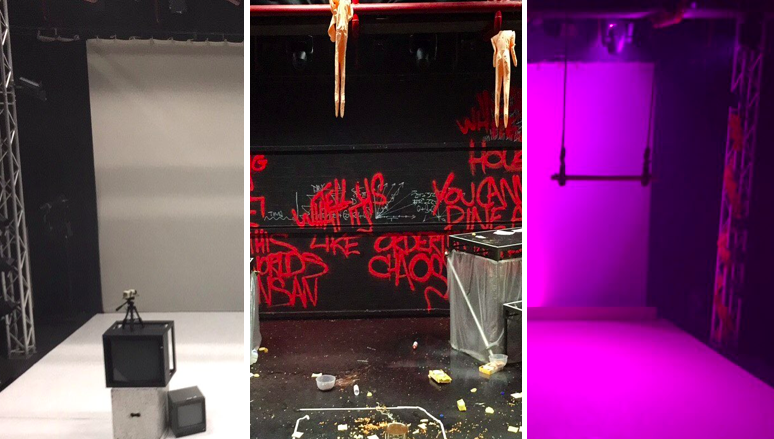My experience on the Contemporary Performance Practice Collaboration festival was one of highs, lows, tears, smiles, very good days and very bad ones. However, reflecting back on it, it was the best allocation I could have hoped to finish first year with.
After I left opera, I spent a week doing ‘prep work’ with Fee, the TSM. Due to the nature of the shows, this meant doing not very much for a long period of time – the most notable exception to this being trailing around Glasgow for a day trying to locate as many pink paint swatches as possible, so that the third CPP3 group could decide on what shade of pink they would like to turn the Chandler. As it was just her and I on the team I was given the more mundane tasks, something that I fully expected and went about promptly; making signs for our TSM cases and pulling equipment from the cage. However, what I had not expected to encounter was a certain communication barrier that had appeared. It seemed like every time I would enquire about why we were doing something a certain way – coming from a place of personal curiosity, with the intention of learning something new – it was seen as a challenge to my superior, and I was shrugged off with a ‘just do it please’. Having spent time with an HOD – in Ben – who had appeared to trust me, certainly more than my current one, this felt unpleasant, though I forced myself to adjust to this new way of working and get on with it, growing to understand what was meant through the vague emails and call times.
So the prep week came and went, the tiny workload allowing me to rest up and drink some Lemsips before what I knew would be a hectic set of weeks to come. Little did I know how true this would be. The first set of groups that we had in the space were the CPP3s. These were three groups of third year students who had developed their own pieces collaboratively between them, without a director to guide the process. The first group wanted the Chandler to go white, something that we achieved by using the sacrificial floor from Opera one, which had been stored in the dock, and hanging one of the Ath cycs on the back wall. This first get in was when I began to remember all the quirks of the Chandler – namely the fact that nothing is at right angles to each other and, depending on what effect you’re trying to achieve, you have the choice of about four different centre and settings lines. Once we’d selected where we wanted to lay the floor, it went down in about fifteen minutes, using the techniques that I’d learnt in the two weeks prior on Opera to ensure the first four boards were perfect, allowing everything else to go down quickly. After some shuffling of what turned out to be different sized boards the floor was down and, following a gaff line around the edge and the tying of the cyc to the back curtain rail, the venue was ready.
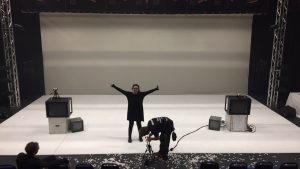 Our Beautiful White Box
Our Beautiful White Box
Then followed tech where, to my confusion and mild horror, I was left to manage the space by myself as the representative of the Stage team, as the TSM had too much work to be getting on with. This was understandable, due to the ever changing nature of the shows coming up, but despite my continued requests I had been left without a plan of things she had wanted to achieve in the venue from day to day, or any prep work that I could be getting along with. This is when the silver lining begins to appear, as it was the first instance of me being forced to think on my feet as a Head of Department, coming up with my own day to day venue plan and working out ways of combating the problems that arose during the tech period, even to the point of writing my own risk assessments to allow me to safely complete some in-show cues. When questions came up of how to safely execute things like our snow drops, I was able to answer using my knowledge from Christmas at the Conservatoire, and I was able to work with the other departments in a way that tested my own ability to think on my feet and come up with my own plans. This was facilitated by Malcy Rogan – our external SM and Stage tutor/guidance counsellor – who was incredibly helpful and supportive any time I would go to him with an idea of how I’d want to do something. To be able to approach someone with years of experience with my own ideas and for them to approve them and then act as my crew to rig them was amazing, and an experience that I feel everyone should have a chance to work through.
The transition from Group A to Group B was where the short fallings of the festival structure became apparent. Due to the entire team coming from long running show allocations, walking into a festival style environment and the differences this brought challenged all of us, with our work ethic and pace not holding up to where it should have been. We had a day and a half to rip up a sacrificial floor, take down a cyc and install four pieces of steel deck. By six o’clock in the evening, with half of this work still incomplete, Malcy and Jazz sat us down for a talk. This was one of the first in a line of what I came to deem ‘hang yourself’ conversations. To have our two industry professionals tell us that our work ethic was ‘shit’, really beat us down – but was also so necessary in making us better and stronger as a team. Our work speed improved, along with the willingness of everyone to work cross discipline and not just stick to what the allocation sheet had said – something that I think is a failing of departmentalising this festival from the outset. What had also prevented the fast movement of the day was the lack of a TSM plan, with my HOD telling me to ‘give the platform rails’ without telling me if we had any preprepared or whether it’d a staff and key clamp affair – as it ended up – or to ‘go brace that’ without measurements or giving me keys to the kit I needed. There was a point at which my gratefulness for being challenged with everything I did ran out, and it just left me feeling unsupported by both my HOD and the rest of the first year crew – with the notable exceptions of Adlai and Callum, who were amazing helps throughout, and made the experience undeniably easier than the disaster it could have been.
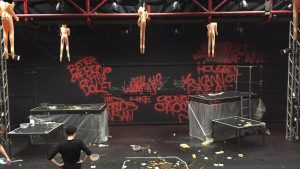 Guess The Reason We Didn’t Do a Wet Run
Guess The Reason We Didn’t Do a Wet Run
But, in the end, Group B went up, the deck looking as industrial as they had wanted, and the pulley system for the *ahem* sex doll flying installed by Fee and operated by myself. One of the sequences was notably impressive, with eight operators flying dolls and microphones at the same time with me cueing them by waving my arm over a bulkhead due to the lack of a DSM. Though this did not invoke some deep epiphany in me about my continued learning development, it just goes to show the kind of off the wall, wacky stuff that makes CPP the delight that it is. That show was another example of me being in the space and treated like a HOD, with the Stage Manager coming to me to ask what I wanted to do about certain aspects of the performance or pre and post show – occasions for which I had begin to plan, under the assumption I would continue to have to take control. The strike into group C was a lot better, the conversation from earlier in the week compelling everyone to pull their finger out and work together. The electrics team went to build a ground row for the back of the stage to hide their cyc lighting whilst I laid the floor with Malcy – this group using the same sacrificial sheets from Group A, only this time in a lovely shade of baby pink. The cyc went back up and the floor got a paint in less time than it had taken us to assemble one platform of the previous disaster.
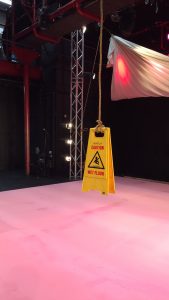
Because when your entire floor is wet, why not fly your safety sign?
This group also had a swing. I arrived delayed on the day the swing was installed, back from a hospital appointment at the end of a morning session. By this point, Fee had installed two pulleys as diverts for hemp to ensure the swing could have its height reset between uses, however this meant that every time the performer put his weight on it, all twelve metres of hemp through the pulleys was stretched, making the swing bounce down by about two feet. This was not ok for show conditions and – as my HOD had left the venue – I was left to sort it out. Christoph, our lighting lecturer, had suggested the use of steel drifts to dead hang it, however I questioned this as, due to the fact he was jumping on the swing, this would mean the drifts would have to be shock rated which – to my knowledge – none of the appropriately sized ones we had were. My suggestion was just to remove the pulleys and tie the hemp directly onto the bars above, limiting the twelve metres to about one and a half and drastically minimising the stretch.
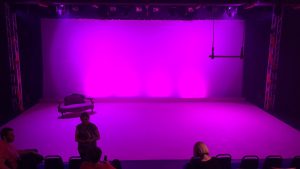
Pretty in Pink
So, Malcy and I set about reworking the swing, with myself tying around twelve knots in total – including the Figure of Eight learnt on Opera – to make sure the performer was in no danger of falling. This would have meant that four knots would have had to have failed to bring the swing down and – with Simon acting as a weight test – the swing proved stable and we progressed with tech. Their group also wanted to fly a large inflatable heart in their piece and, by repurposing a spare scaff bar and some pulleys we had lying around from the dolls, I rigged a basic system for making this happen, with a clamp on the catwalk to make sure the piece was hidden pre show. To make this happen, I had to liase with the lighting department about moving some of their lamps, and it was really nice to see them take to me as a HOD, and be willing to change their design because of the way I wanted to rig something. I felt supported and valued as an integral member of the team – something that I had been lacking up to that point.
To conclude my CPP3 experience, though the situation of support from my HOD did not get better in any way, I feel my ability to deal with it did. By being present in the space and by being respected and looked to by other members of the production team, I felt under constant pressure from myself to prove that I knew what I was doing; pressure that – I feel – was beneficial to improving the quality of my work . I managed to work with the teams I was given and the teams I could assemble around me to deal with a multitude of different and difficult circumstances, and achieve the outcome the performers and creatives wanted, whilst devising plans to manage strikes and rigs for the following performances. Looking forward from this, when I next find myself in a management role, I would like to ensure I have proper communication with my team – and notably anyone acting as my deputy. I know how I have enjoyed the freedom I have been given, and would be willing to give that freedom to someone else if they thought they could handle it. But I feel I need to make sure the proper support is in place if there is any point where they feel they can’t cope – support I feel just wasn’t there in my case.

